
Diplolepis is a genus of approximately fifty species of gall-inducing wasps in the family Diplolepididae. The larvae induce galls on wild roses (Rosa), and rarely on domestic roses.

Casuarina, also known as Australian pine and native pine, is a genus of flowering plants in the family Casuarinaceae, and is native to Australia, the Indian subcontinent, Southeast Asia, islands of the western Pacific Ocean, and eastern Africa.
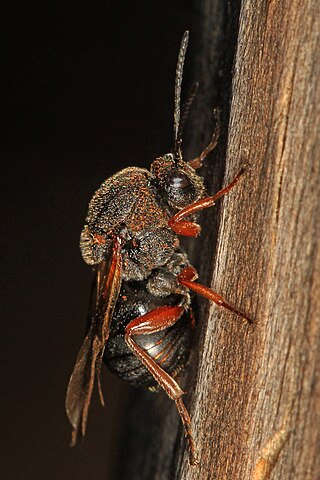
Gall wasps, also traditionally calledgallflies, are hymenopterans of the family Cynipidae in the wasp superfamily Cynipoidea. Their common name comes from the galls they induce on plants for larval development. About 1,300 species of this generally very small creature are known worldwide, with about 360 species of 36 different genera in Europe and some 800 species in North America.
Cecidosidae is a family of primitive monotrysian moths in the order Lepidoptera which have a piercing ovipositor used for laying eggs in plant tissue in which they induce galls, or they mine in bark. Nine species occur in southern Africa, five species in South America and Xanadoses nielseni was recently described from New Zealand. Some minute parasitoid wasps are known.

Schinus engleri is a species of plant in the family Anacardiaceae. It is found in Argentina, Brazil, and Uruguay. It is threatened by habitat loss. They are most abundantly found on the southern coast of Uruguay near Montevideo. They are pepper trees that are important to Eucecidoses Minutanus to create galls on.
Emersonella is a genus of hymenopteran insects of the family Eulophidae. Several species are known to be phoretic parasitoids of female tortoise beetles, laying their eggs in the eggs of the beetle host.
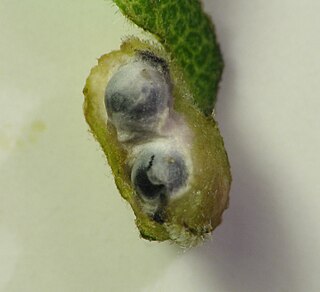
Galeopsomyia is a New World genus of hymenopteran insects of the family Eulophidae. The genus is a hyperparasitoid of other gall-inducing wasps of the genera Eurytoma and Torymus.
Kokandia is a monotypic genus of hymenopteran insects of the family Eulophidae. The only known species Kokandia salsolicola is a parasitoid of gall midges belonging to the family Cecidomyiidae which use plants of the goosefoot genus Salsola as hosts.

Leptocybe invasa, the blue gum chalcid wasp or eucalyptus gall wasp, is a chalcid wasp which is the only species in the monotypic genus Leptocybe in the subfamily Tetrastichinae, of the family Eulophidae. It is a gall wasp which causes the formation of galls on a number of species of Eucalyptus, it was described in 2004 after galls were found in river red gums in the Mediterranean and Middle East and has since been found to be a widespread species where its host trees are planted. It is indigenous to Australia.

Quadrastichus is a genus of hymenopteran insects of the family Eulophidae.

Ophelimus maskelli is a species of chalcid wasp about 1mm long, known as the eucalyptus gall wasp, indigenous to Australia and New Zealand, and invasive in the Mediterranean, the Middle East, North Africa, South Africa, tropical Asia, and the United States (California). It is considered a plant pest as females lay eggs on immature eucalyptus leaves; the larvae produce galls on the leaves. Heavy infestations induce much galling which causes widespread defoliation and loss of growth. Wasps may emerge in large numbers in the spring, forming clouds which are a nuisance to humans.

Cynipini is a tribe of gall wasps. These insects induce galls in plants of the beech and oak family, Fagaceae. They are known commonly as the oak gall wasps. It is the largest cynipid tribe, with about 936 to 1000 recognized species, most of which are associated with oaks. The tribe is mainly native to the Holarctic.
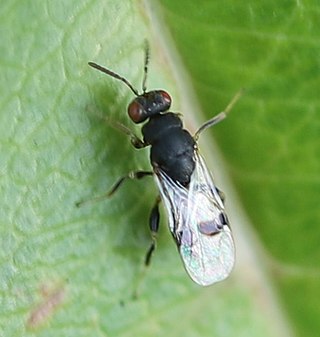
Sycophila is a genus of wasp that associates with figs and galls of various insects such as gall wasps and gall midges. They have a cosmopolitan distribution.

Quadrastichus erythrinae Kim, 2004, is a small parasitoid wasp belonging to the family Eulophidae, but also a secondary phytophage by way of inducing galls on the leaves, stems, petioles and young shoots of various Erythrina species.
Smilax havanensis is a plant species native to Cuba, the Cayman Islands, Bahamas, Turks & Caicos, and southern Florida.
Cecinothofagus gallaecoihue is a species of gall wasp. Cecinothofagus species are thought to be parasitoids or lethal inhabitants of galls induced by species of Aditrochus on Nothofagus.
Cecinothofagus ibarrai is a species of gall wasp. Cecinothofagus species are thought to be parasitoids or lethal inhabitants of galls induced by species of Aditrochus on Nothofagus.
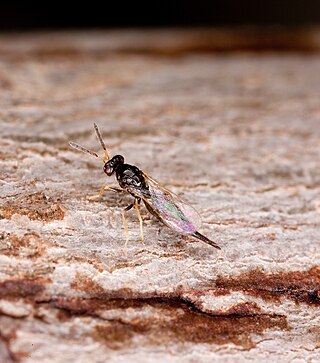
Tetrastichinae is a subfamily of the chalcid wasp family Eulophidae. It is one of the largest subfamilies of the Eulophidae containing over 100 genera and nearly 3,000 species. The species of the family Tetrastichinae are found in almost any type of terrestrial habitat and have a worldwide distribution, except Antarctica. They show a varied biology and hosts for Tetrastichinae wasps have been identified from over 100 different insect families, across 10 different orders and they have also been recorded as being parasitoids on nematodes, mites and spiders' eggs. Some species are even phytophagous, while others are inquilines and yet others are gall formers.
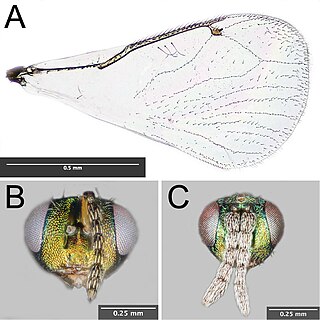
Euderus set, the crypt-keeper wasp, is a tiny chalcid wasp from the family Eulophidae from the United States, described in 2017 as a parasitoid of the gall wasp Bassettia pallida, and the description of its life cycle attracted widespread publicity.
Leprosa milga is a species of Afrotropical wasp in the family Eulophidae, the only member of the genus Leprosa. It is a gall wasp which induces the production of galls on the seed pods of species in the genus Eucalyptus. It probably originated in Australia but has been recorded from South Africa and Italy.












